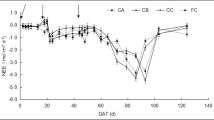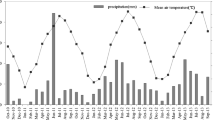Abstract
As the effective measures in sequestrating carbon (C) of rice paddies, performance of straw returning (SR) and straw-derived biochar application (BA) on the basis of the same C input in regulating CO2 fluxes in atmosphere-rice plant-paddy soil ecosystem under different irrigation mode was monitored across the whole growth stage. Two irrigation managements (i.e., flooding irrigation (FI) and controlled irrigation (CI)) and three carbon managements (i.e., no carbon treatment (K), SR and BA) were set up in a bucket experiment. CO2 fluxes were measured using chamber technology. CI led to an increase in rice leaf instantaneous water use efficiency (WUEleaf) by enhancing rice photosynthetic rate (A) and reducing rice stomatal conductance to water (gsw). Additionally, both BA and SR showed a significant improvement on soil organic carbon (SOC) and net ecosystem exchange of CO2 (NEE), although they promoted soil respiration (Rs). BA was particularly effective in increasing these two parameters. The study also found significant relationships between Rs, gross primary productivity (GPP) and NEE, suggesting that CO2 emission from paddy soil can promote rice photosynthesis. Both BA and SR enhanced the carbon sink function of paddies and reduced soil net carbon loss in water-saving irrigated paddy fields. These results can inform the development of agricultural management measures to improve the carbon sequestration function of rice field ecosystems and aid in the formulation of emission reduction strategies by the government.




Similar content being viewed by others
Data Availability
Not applicable.
References
Chen L, Zhang JB, Zhao BZ, Yan P, Zhou GX, Xin XL (2014) Effects of straw amendment and moisture on microbial communities in Chinese fluvo-aquic soil. J Soil Sediment 14:1829–1840. https://doi.org/10.1007/s11368-014-0924-2
Chen MP, Cui YR, Jiang S, Forsell N (2022) Toward carbon neutrality before 2060: trajectory and technical mitigation potential of non-CO2 greenhouse gas emissions from Chinese agriculture. J Clean Prod 368:133186. https://doi.org/10.1016/j.jclepro.2022.133186
Fan RQ, Zhang BH, Li JY, Zhang ZH, Liang AZ (2020) Straw-derived biochar mitigates CO2 emission through changes in soil pore structure in a wheat-rice rotation system. Chemosphere 243:125329. https://doi.org/10.1016/j.chemosphere.2019.125329
Hibbard KA, Law BE, Reichstein M, Sulzman J (2005) An analysis of soil respiration across northern hemisphere temperate ecosystems. Biogeochemistry 73:29–70. https://doi.org/10.1007/s10533-004-2946-0
Hu JZ, Wang J, Yang SH, Qi ST, Jiang ZW, Dai HD, Zhou JY (2022) Soil nitrogen functional transformation microbial genes response to biochar application in different irrigation paddy field in southern China. Environ Sci Pollut R 30:7770–7785. https://doi.org/10.1007/s11356-022-22728-z
Huang JY, Nie TZ, Li TC, Chen P, Zhang ZX, Zhu SJ, Sun ZY, Lihua E (2022) Effects of Straw Incorporation years and Water-saving irrigation on Greenhouse Gas emissions from Paddy Fields in Cold Region of Northeast China. Agriculture-Basel 12:1878. https://doi.org/10.3390/agriculture12111878
Jabro JD, Sainju U, Stevens WB, Evans RG (2008) Carbon dioxide flux as affected by tillage and irrigation in soil converted from perennial forages to annual crops. J Environ Manage 88:1478–1484. https://doi.org/10.1016/j.jenvman.2007.07.012
Jeong K, Hong T, Kim J (2018) Development of a CO2 emission benchmark for achieving the national CO2 emission reduction target by 2030. Energ Build 158:86–94. https://doi.org/10.1016/j.enbuild.2017.10.015
Johnson JL, Temple KL (1964) Some variables affecting the measurement of catalase activity in Soil. Soil Sci Soc Am J 28:207–209. https://doi.org/10.2136/sssaj1964.03615995002800020024x
Keith A, Singh B, Dijkstra FA (2015) Biochar reduces the rhizosphere priming effect on soil organic carbon. Soil Biol Biochem 88:372–379. https://doi.org/10.1016/j.soilbio.2015.06.007
Li W, Xu L, Jin Y (2022) The influence factors of interprovincial power transmission on China’s CO2 emissions. Sci Prog 105:368504221137466. https://doi.org/10.1177/00368504221137466
Liu C, Lu M, Cui J, Li B, Fang CM (2014) Effects of straw carbon input on carbon dynamics in agricultural soils: a meta-analysis. Global Change Biol 20:1366–1381. https://doi.org/10.1111/gcb.12517
Liu Z, Liu WT, Liu HT, Gao TP, Zhao HX, Li G, Han HF, Li ZJ, Lal R, Ning TY (2020) Capture of soil respiration for higher photosynthesis with lower CO2 emission. J Clean Prod 246:119029. https://doi.org/10.1016/j.jclepro.2019.119029
Liu YL, Ge TD, van Groenigen KJ, Yang YH, Wang P, Cheng K, Zhu ZK, Wang JK, Li Y, Guggenberger G, Sardans J, Penuelas J, Wu JS, Kuzyakov Y (2021a) Rice paddy soils are a quantitatively important carbon store according to a global synthesis. Commun Earth Environ 2:154. https://doi.org/10.1038/s43247-021-00229-0
Liu ZW, Wu XL, Li SX, Liu W, Bian RJ, Zhang XH, Zheng JF, Drosos M, Li LQ, Pan GX (2021b) Quantitative assessment of the effects of biochar amendment on photosynthetic carbon assimilation and dynamics in a rice-soil system. New Phytol 232:1250–1258. https://doi.org/10.1111/nph.17651
Lu WW, Ding WX, Zhang JH, Li Y, Luo JF, Bolan N, Xie ZB (2014) Biochar suppressed the decomposition of organic carbon in a cultivated sandy loam soil: a negative priming effect. Soil Biol Biochem 76:12–21. https://doi.org/10.1016/j.soilbio.2014.04.029
Ly P, Vu QD, Jensen LS, Pandey A, de Neergaard A (2015) Effects of rice straw, biochar and mineral fertiliser on methane (CH4) and nitrous oxide (N2O) emissions from rice (Oryza sativa L.) grown in a rain-fed lowland rice soil of Cambodia: a pot experiment. Paddy Water Environ 13:465–475. https://doi.org/10.1007/s10333-014-0464-9
Ma YC, Liu DL, Schwenke G, Yang B (2019) The global warming potential of straw-return can be reduced by application of straw-decomposing microbial inoculants and biochar in rice-wheat production systems. Environ Pollu 252:835–845. https://doi.org/10.1016/j.envpol.2019.06.006
Ma LJ, Kong FX, Lv X, Wang Z, Zhou ZG, Meng YL (2021) Responses of greenhouse gas emissions to different straw management methods with the same amount of carbon input in cotton field. Soil Tillage Res 213:105126. https://doi.org/10.1016/j.still.2021.105126
Niu LA, Hao JM, Zhang BZ, Niu XS (2011) Influences of long-term fertilizer and Tillage Management on Soil Fertility of the North China Plain. Pedosphere 21:813–820. https://doi.org/10.1016/S1002-0160(11)60185-9
Peyron M, Bertora C, Pelissetti S, Said-Pullicino D, Celi L, Miniotti E, Romani M, Sacco D (2016) Greenhouse gas emissions as affected by different water management practices in temperate rice paddies. Agr Ecosyst Environ 232:17–28. https://doi.org/10.1016/j.agee.2016.07.021
Qi L, Pokharel P, Chang SX, Zhou P, Niu HD, He XH, Wang ZF, Gao M (2020) Biochar application increased methane emission, soil carbon storage and net ecosystem carbon budget in a 2-year vegetable-rice rotation. Agr Ecosyst Environ 292:106831. https://doi.org/10.1016/j.agee.2020.106831
Saurer M, Siegwolf RTW, Schweingruber FH (2004) Carbon isotope discrimination indicates improving water-use efficiency of trees in northern Eurasia over the last 100 years. Global Change Biol 10:2109–2120. https://doi.org/10.1111/j.1365-2486.2004.00869.x
Tang H (2013) Greenhouse gases Emission from Paddy Fields as affected by Rice Straw Incorporation and its response to Water Regime. Hunan Agricultural University
Tang JC, Liu TQ, Jiang Y, Nie JF, Xing JY, Zhang L, Zhang WJ, Tan WF, Cao CG (2022) Current status of carbon neutrality in Chinese rice fields (2002–2017) and strategies for its achievement. Sci Total Environ 842:156713. https://doi.org/10.1016/j.scitotenv.2022.156713
Wang R (2018) The effect of straw incorporation on greenhouse gases emission and change of dissolved organic carbon componet. Huazhong Agricultural University
Wang JB, Chen ZH, Chen LJ, Zhu AN, Wu ZJ (2011) Surface soil phosphorus and phosphatase activities affected by tillage and crop residue input amounts. Plant Soil Environ 57:251–257. https://doi.org/10.17221/437/2010-PSE
Wang YC, Tao FL, Yin LC, Chen Y (2022) Spatiotemporal changes in greenhouse gas emissions and soil organic carbon sequestration for major cropping systems across China and their drivers over the past two decades. Sci Total Environ 833:155087. https://doi.org/10.1016/j.scitotenv.2022.155087
Xu Y, Ge JZ, Tian SY, Li SY, Nguy-Robertson AL, Zhan M, Cao CG (2015) Effects of water-saving irrigation practices and drought resistant rice variety on greenhouse gas emissions from a no-till paddy in the central lowlands of China. Sci Total Environ 505:1043–1052. https://doi.org/10.1016/j.scitotenv.2014.10.073
Yang SH, Liu XJ, Liu XY, Xu JZ (2017) Effect of water management on soil respiration and NEE of paddy fields in Southeast China. Paddy Water Environ 15:787–796. https://doi.org/10.1007/s10333-017-0591-1
Yang SH, Xiao YN, Xu JZ, Liu XY (2018) Effect of straw return on soil respiration and NEE of paddy fields under water-saving irrigation. PLoS ONE 13:e0204597. https://doi.org/10.1371/journal.pone.0204597
Yang SH, Chen X, Jiang ZW, Ding J, Sun X, Xu JZ (2020a) Effects of Biochar Application on Soil Organic Carbon composition and enzyme activity in Paddy Soil under Water-saving irrigation. Int J Env Res Pub He 17:333. https://doi.org/10.3390/ijerph17010333
Yang SH, Sun X, Ding J, Jiang ZW, Liu XY, Xu JZ (2020b) Effect of biochar addition on CO2 exchange in paddy fields under water-saving irrigation in Southeast China. J Environ Manage 271:111029. https://doi.org/10.1016/j.jenvman.2020.111029
Zhang ZS, Cao CG, Guo LJ, Li CF (2016) Emissions of CH4 and CO2 from paddy fields as affected by tillage practices and crop residues in central China. Paddy Water Environ 14:85–92. https://doi.org/10.1007/s10333-015-0480-4
Zhang ZM, Wang ZB, Zhang ZX, Wang XL (2018) Effects of different irrigations on Carbon Emission, Water Consumption and Yield of Paddy Field in Cold regions. J Irrig Drain 37:1–7. https://doi.org/10.13522/j.cnki.ggps.20180099
Zhang XX, Zhou S, Sun HD, Zhang JN, Wang C (2020) Impacts of alternate wetting and drying irrigation on rice production and the mitigation of greenhouse gas emission in paddy fields. Chin J Ecol 39:3873–3880. https://doi.org/10.13292/j.1000-4890.202011.001
Zhang H, Liang S, Wang YH, Liu SW, Sun HD (2021) Greenhouse gas emissions of rice straw return varies with return depth and soil type in paddy systems of Northeast China. Arch Agron Soil Sci 67:1591–1602. https://doi.org/10.1080/03650340.2020.1800644
Zhao X, Zhang R, Xue JF, Pu C, Zhang XQ, Liu SL, Chen F, Lal R, Zhang HL (2015) Management-Induced changes to Soil Organic Carbon in China: a Meta-analysis. Adv Agron
Zhao XM, He L, Zhang ZD, Wang HB, Zhao LP (2016) Simulation of accumulation and mineralization (CO2 release) of organic carbon in chernozem under different straw return ways after corn harvesting. Soil Tillage Res 156:148–154. https://doi.org/10.1016/j.still.2015.11.001
Zhu LQ, Li J, Tao BR, Hu NJ (2015) Effect of different fertilization modes on soil organic carbon sequestration in paddy fields in South China: a meta-analysis. Ecol Indic 53:144–153. https://doi.org/10.1016/j.ecolind.2015.01.038
Acknowledgements
This work was supported by the Postgraduate Research & Practice Program of Jiangsu Province (422003246), the Key R&D Plan Projects in Jiangsu Province (BE2022390), the Water Conservancy Science and Technology Project of Jiangxi Province (202325ZDKT03), National Natural Science Foundation of China (51879076).
Author information
Authors and Affiliations
Contributions
S.Q.: Conceptualization, Data curation, Software, Writing—original draft. S.Y.: Funding acquisition, Writing—review & editing. W.Y.: Validation, Writing—review & editing. J.H.: Data curation, Writing– review & editing. C.M.: Data curation. Z.J.: Data curation, Writing—review & editing. H.Q.: Software, Methodology. Y.X.: Methodology, Writing—review & editing.
Corresponding author
Ethics declarations
Competing Interest
The authors declare that they have no known competing financial interests or personal relationships that could have appeared to influence the work reported in this paper.
Additional information
Publisher’s Note
Springer Nature remains neutral with regard to jurisdictional claims in published maps and institutional affiliations.
Electronic Supplementary Material
Below is the link to the electronic supplementary material.
Rights and permissions
Springer Nature or its licensor (e.g. a society or other partner) holds exclusive rights to this article under a publishing agreement with the author(s) or other rightsholder(s); author self-archiving of the accepted manuscript version of this article is solely governed by the terms of such publishing agreement and applicable law.
About this article
Cite this article
Qi, S., Yang, S., Yu, W. et al. CO2 Fluxes Over Water-Saving Paddy Fields with Different Straw Management Methods on the Basis of the Same Amount of Carbon Input. J Soil Sci Plant Nutr (2024). https://doi.org/10.1007/s42729-024-01679-z
Received:
Accepted:
Published:
DOI: https://doi.org/10.1007/s42729-024-01679-z




